Notebook of Gerard Henderson Cowan - Part 8
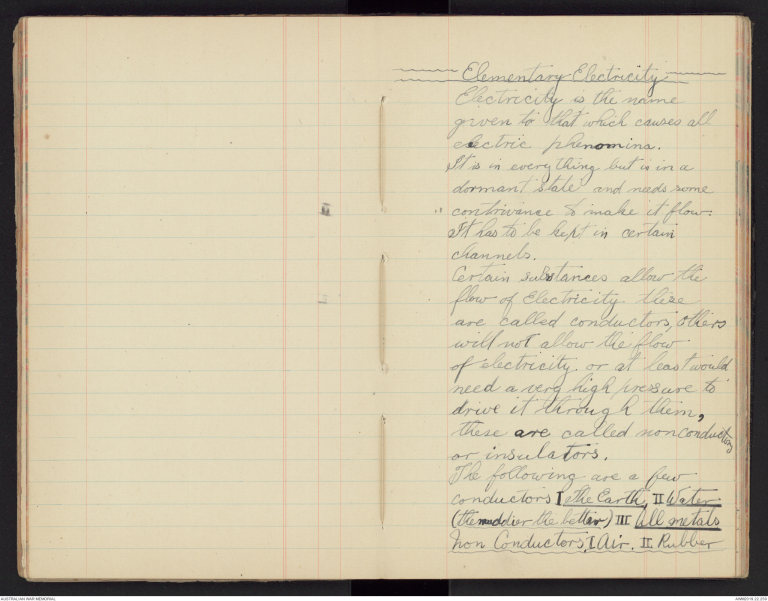
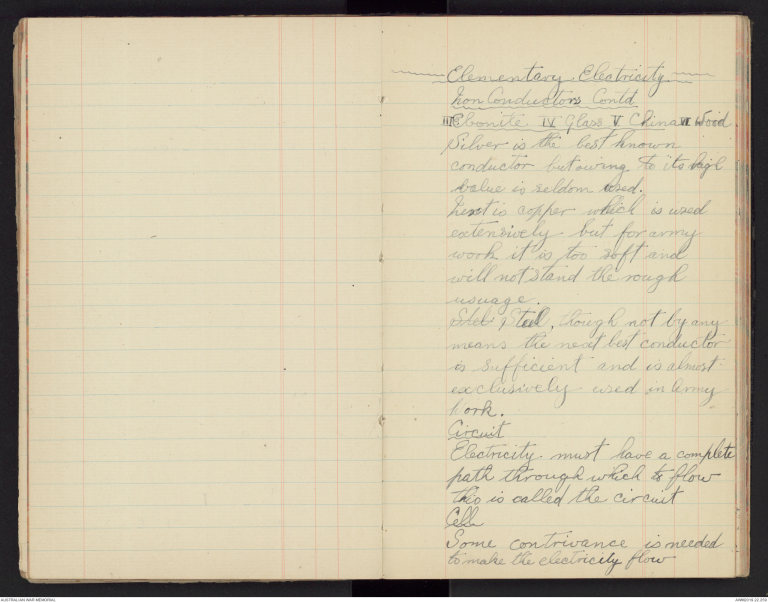
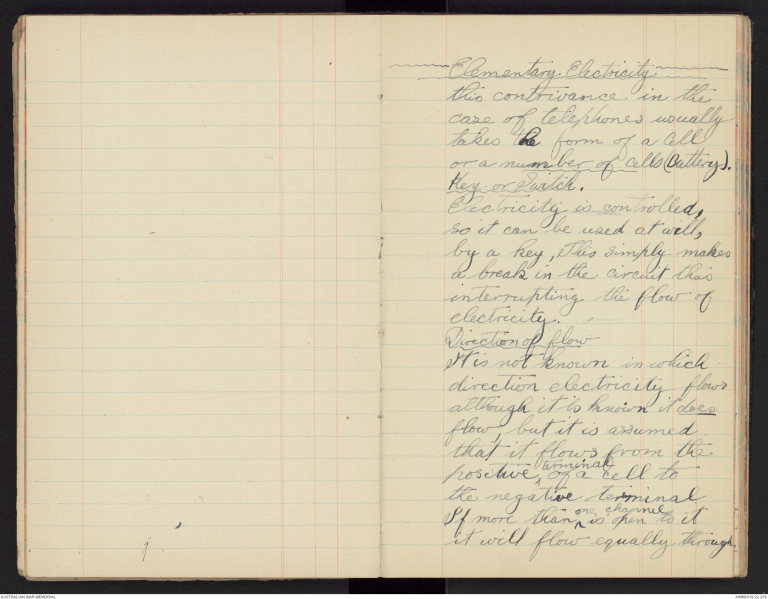
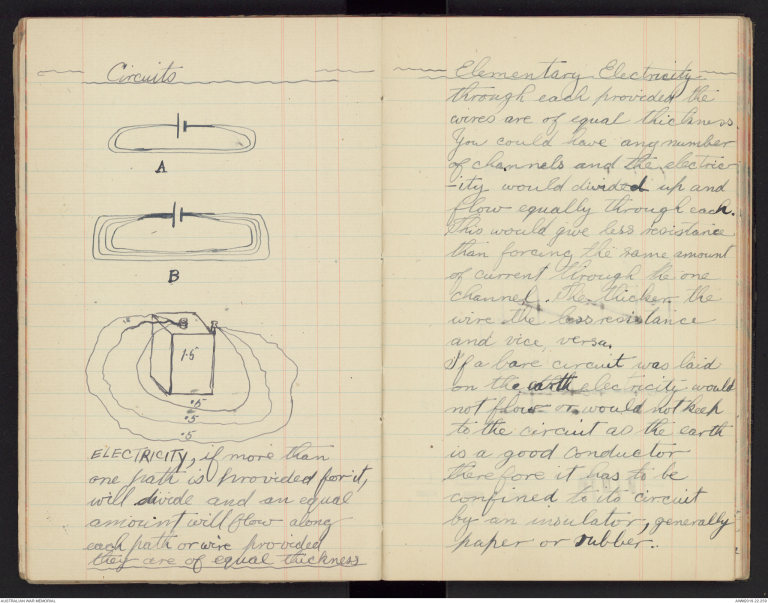
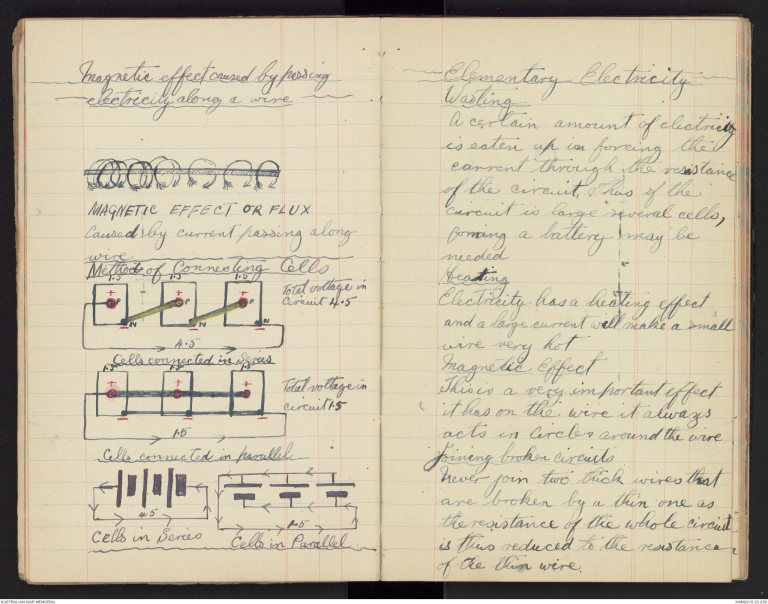
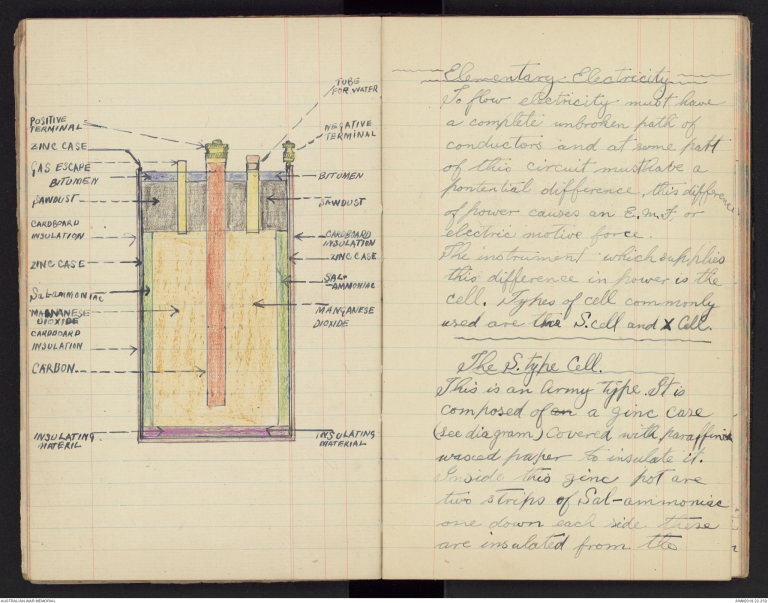
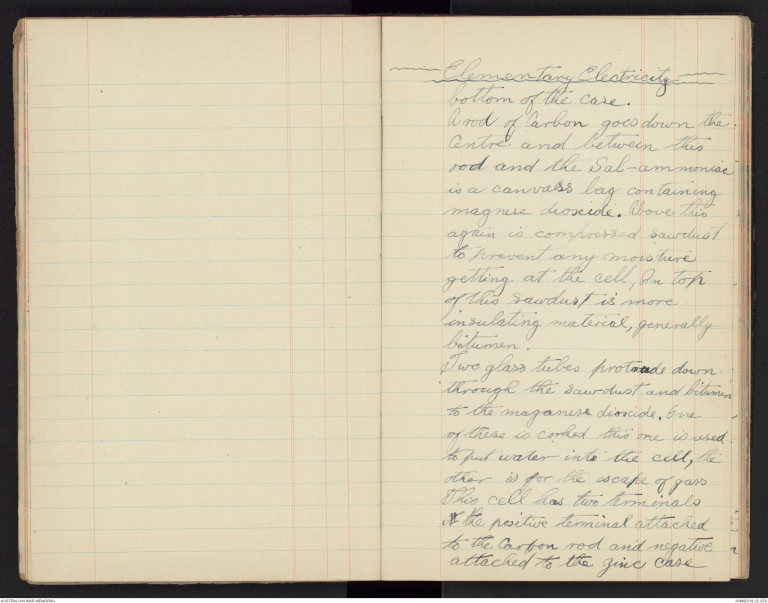
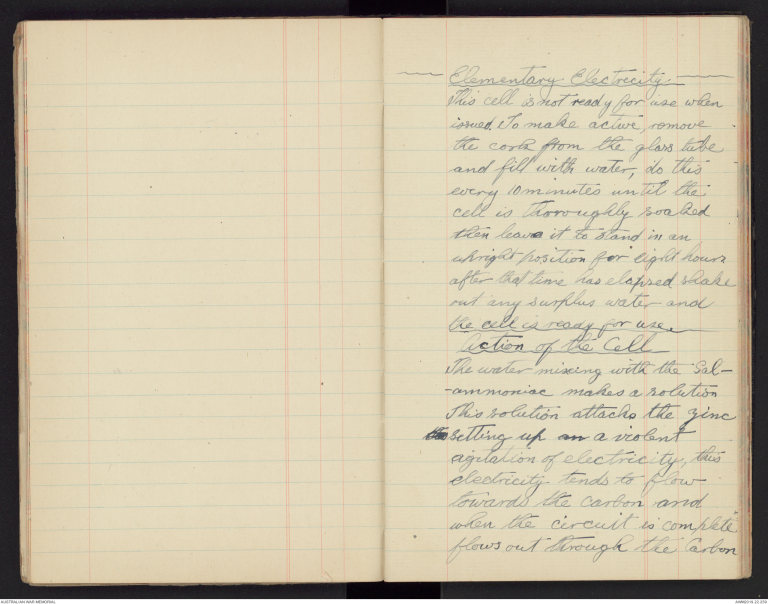
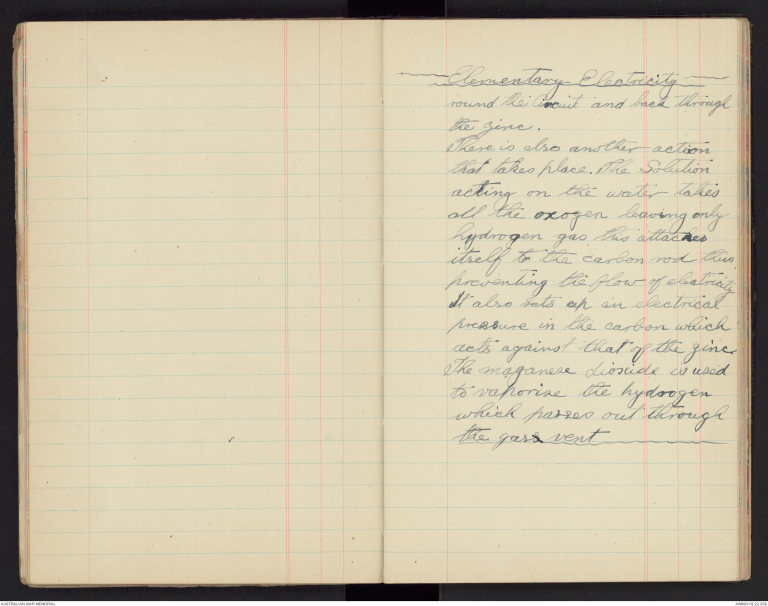
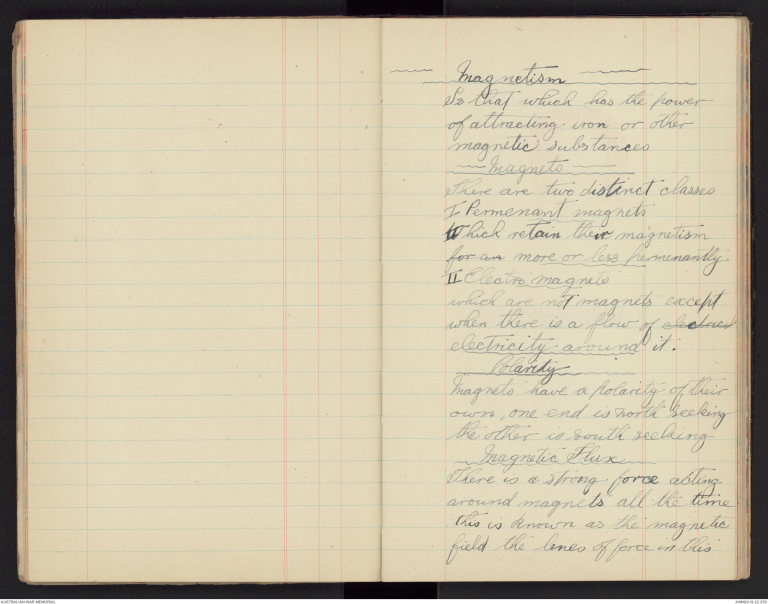
Elementary Electricity
Electricity is the name
given to that which causes all
electric phenomina.
It is in everything but is in a
dormant state and needs some
contrivance to make it flow.
It has to be kept in a certain
channels.
Certain substances allow the
flow of Electricity these
are called conductors, others
will not allow the flow
of electricity or at least would
need a very high pressure to
drive it through them,
these are called nonconductors
or insulators.
The following are a few
conductors I The Earth, II Water
(the muddier the better) III All metals
Non Conductors, I Air. II Rubber
Elementary Electricity
Non Conductors Contd
III Ebonite IV Glass V China VI Wood
Silver is the best known
conductor but owing to its high
value is seldom used.
Next is copper which is used
extensively but for army
work it is too soft and
will not stand the rough
usuage.
Stel , Steel, though not by any
means the next best conductor
is sufficient and is almost
exclusively used in Army
Work.
Circuit
Electricity must have a complete
path through which to flow
this is called the circuit
Cell
Some contrivance is needed
to make the electricity flow
Elementary Electricity
this contrivance in the
case of telephones usually
takes the form of a Cell
or a number of cells (Battery)
Key or Switch
Electricity is controlled,
so it can be used at will,
by a key, This simply makes
a break in the circuit thus
interrupting the flow of
electricity.
Direction of flow
It is not known in which
direction electricity flows
although it is known it does
flow, but it is assumed
that it flows from the
positive terminal of a cell to
the negative terminal
If more than one channel is open to it
it will flow equally through
Circuits
|
A Hand drawn diagram |
|
B Hand drawn diagram |
|
C Hand drawn diagram |
ELECTRICITY, if more than
one path is provided for it,
will divide and an equal
amount will flow along
each path or wire provided
they are of equal thickness
Elementary Electricity
through each provided the
wires are of equal thickness.
You could have any number
of channels and the electricity
would divided up and
flow equally through each.
This would give less resistance
than forcing the same amount
of current through the one
channel. The thicker the
wire the less resistance
and vice versa.
If a bare circuit was laid
on the earth electricity would
not flow or would not keep
to the circuit as the earth
is a good conductor
therefore it has to be
confined to its circuit
by an insulator, generally
paper or rubber.
Magnetic effect caused by passing
electricity along a wire
|
Hand drawn diagram MAGNETIC EFFECT OR FLUX Caused by current passing along wire |
|
Method of Connecting Cells Hand drawn diagram Total voltage in circuit 4.5 |
|
Cells connected in series Hand drawn diagram Total voltage in circuit 1.5 |
|
Cells connected in parallel Hand drawn diagram Cells in series Cells in parallel |
Elementary Electricity
Wasting
A certain amount of electricity
is eaten up in forcing the
current through the resistance
of the circuit. Thus if the
circuit is large several cells,
forming a battery may be
needed.
Heating
Electricity has a heating effect
and a large current will make a small
wire very hot
Magnetic Effect
This is a very important effect
it has on the wire it always
acts in circles around the wire
Joining broken circuits
Never join two thick wires that
are broken by a thin one as
the resistance of the whole circuit
is thus reduced to the resistance
of the thin wire.
Hand drawn diagram-see original
Elementary Electricity
To flow electricity must have
a complete unbroken path of
conductors and at some part
of this circuit must have a
pontential difference, this difference
of power causes an E.M.F. or
electric motive force.
The instrument which supplies
this difference in power is the
cell. Types of cell commonly
used are the S. Cell and X. Cell.
The S. type Cell
This is an Army type. It is
composed of an a zinc case
(see diagram) covered with paraffined
waxed paper to insulate it.
Inside this zinc pot are
two strips of Sal-ammoniac
one down each side these
are insulated from the
Elementary Electricity
bottom of the case.
A rod of Carbon goes down the
centre and between this
rod and the Sal-ammoniac
is a canvass bag containing
magnese dioxide. Above this
again is compressed sawdust
to prevent any moisture
getting at the cell, On top
of this sawdust is more
insulating material, generally
bitumen.
Two glass tubes protrude down
through the sawdust and bitumen
to the manganese dioxide. One
of these is corked this one is used
to put water into the cell, the
other is for the escape of gass
This cell has two terminals
T the positive terminal attached
to the carbon rod and negative
attached to the zinc case.
Elementary Electricity
This cell is not ready for use when
issued. To make active, remove
the cork from the glass tube
and fill with water, do this
every 10 minutes until the
cell is thoroughly soaked
then leave it to stand in an
upright position for eight hours
after that time has elapsed shake
out any surplus water and
the cell is ready for use.
Action of the Cell
The water mixing with the Sal-ammoniac
makes a solution
This solution attacks the zinc
XXXX setting up an a violent
agitation of electricity, this
electricity tend to flow
towards the carbon and
when the circuit is complete
flows out through the Carbon
Elementary Electricity
round the Circuit and back through
the zinc.
There is also another action
that takes place. The Solution
acting on the water takes
all the oxygen leaving only
hydrogen gas this attaches
itself to the carbon rod thus
preventing the flow of electricity
It also sets up an electrical
pressure in the carbon which
acts against that of the zinc
The maganese dioxide is used
to vaporise the hydrogen
which passes out through
the gass vent.
Magnetism
Is that which has the power
of attracting iron or other
magnetic substances
Magnets
There are two distinct classes
I Permenant magnets
which retain their magnetism
for an more or less permanently
II Electro magnets
which are not magnets except
when there is a flow of electric
electricity around it.
Polarity
Magnets have a polarity of their
own, one end id north seeking
the other is south seeking.
Magnetic Flux
There is a strong force acting
around magnets all the time
this is known as the magnetic
field the lines of force in this
 Kimberley Hayes
Kimberley Hayes This transcription item is now locked to you for editing. To release the lock either Save your changes or Cancel.
This lock will be automatically released after 60 minutes of inactivity.